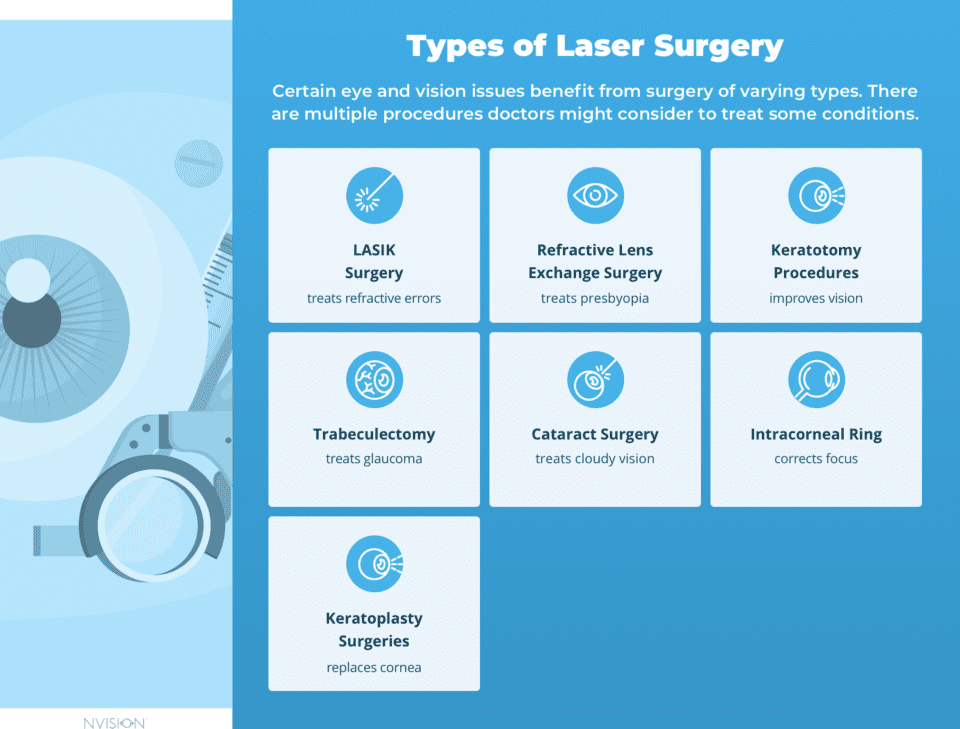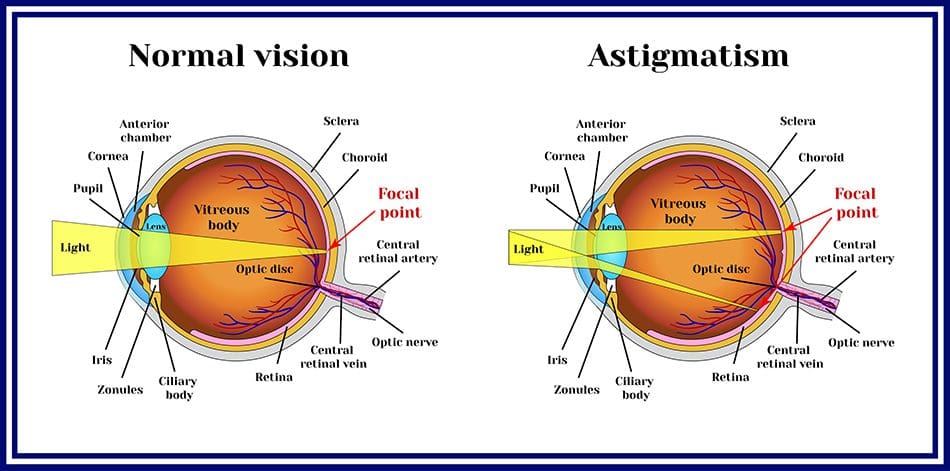Types of Eye Surgery: An Exhaustive Guide
Home /
Certain eye and vision issues benefit from surgery of varying types. There are multiple procedures doctors might consider to treat certain conditions, including:
- LASIK Surgery
- Refractive Lens Exchange Surgery
- Cataract Surgery
- Trabeculectomy
- Keratotomy Procedures
- Keratoplasty Surgeries
- Intracorneal Ring
Each procedure is tailored to the individual’s condition and overall eye health.
Table of Contents
We’ll go into detail about various types of eye surgery but for a quick understanding of each, see the following table:
| Eye Surgery Type | Purpose | Key Details |
|---|---|---|
| LASIK Surgery | To correct refractive errors | Uses a computer-controlled excimer laser to reshape the cornea |
| Refractive Lens Exchange Surgery | To treat presbyopia and severe hyperopia | Replaces the natural lens with an artificial one for sharper focus |
| Cataract Surgery | To improve vision affected by cataracts | Removes the cloudy natural lens and replaces it with a clear artificial one |
| Trabeculectomy | To treat glaucoma | Lowers eye pressure; can be used alone or with eye drops |
| Keratotomy Procedures | To improve vision, commonly used to correct astigmatism | Involves making incisions in the cornea to modify its shape |
| Keratoplasty Surgeries | To replace a damaged natural cornea | Involves removing and replacing the damaged layers of the cornea |
| Intracorneal Ring | To treat conditions like keratoconus, low myopia, and post-LASIK keratectasia | Involves the insertion of crescent-shaped plastic rings into the cornea |
LASIK Surgery

LASIK is a type of laser eye surgery used to correct different types of refractive errors, including hyperopia, myopia, and astigmatism. The surgeon uses an excimer cold laser that is controlled by a computer to reshape the cornea.

There are four primary types of LASIK.
- Waterfront-guided LASIK: This type utilizes measurements of how light goes through the eye to target individual vision and eye anatomy.
- All-laser LASIK: This type uses a femtosecond laser in place of a surgical blade.
- Wavefront-optimized or wavefront-guided LASIK: This type uses detailed cornea curvature measurements to preserve the front surface of the eye’s natural aspheric shape.
- Topography-guided LASIK: This type uses mapping technologies for a more tailored treatment.
To perform LASIK, the surgeon numbs the eyes using eye drops so the patient is comfortable. They then use either a surgical blade or a femtosecond laser to create a corneal flap. The surgeon removes a thin tissue layer so the cornea is flattened.
To complete the procedure, the flap is put back into place. No stitches are necessary to keep the flap in place as it reattaches by itself.
Refractive Lens Exchange Surgery
This surgery is performed for presbyopia. It can also be done for severe hyperopia.
It can alleviate the need for corrective lenses because it replaces the natural lens in the eye with an artificial one. The artificial lens allows for sharper focus.
The procedure is nearly identical to cataract surgery. For the procedure, the natural lens is removed through tiny incisions, and the new lens is put into its place.
Cataract Surgery

When a cataract is present, the natural lens becomes cloudy. This can cause vision to become hazy and blurry, and colors to appear less vibrant.
The purpose of cataract surgery is to remove this lens and replace it with an artificial one that is clear. There are some basic steps that a surgeon follows.
- They numb the eye with eye drops.
- They make tiny incisions close to the cornea’s edge.
- They break up the lens and remove it.
- They insert the new lens.
Trabeculectomy
This surgery is performed to treat glaucoma by helping to lower eye pressure. It can be used alone or with eye drops that help to lower eye pressure.
There are different types of trabeculoplasty surgery.
- Traditional trabeculoplasty
- Argon laser trabeculoplasty
- Micropulse diode laser trabeculoplasty (MDLT)
- Selective laser trabeculoplasty
The general premise is the same, no matter which type of trabeculectomy is performed. The selective laser type is often considered first.
On average, this procedure is successful for about 80 percent of people who undergo it. It helps to alleviate eye pressure by approximately 20 to 30 percent, on average.
The beneficial effects of the procedure last for three to five years for most people. Once the effects start to wear off, selective laser trabeculoplasty can be repeated.
This type of surgery is usually considered before other surgeries are used on people with glaucoma. The following basic steps are typically followed:
- The eye is numbed with eye drops.
- A lens and special microscope are used to guide the laser.
- Small burns are made into the eye’s trabecular meshwork.
- The doctor inputs eye drops to prevent an immediate rise in eye pressure.
Keratotomy Procedures
Keratotomy involves cutting the cornea, often to improve vision. There are two primary types.
- Astigmatic keratotomy
- Radial keratotomy
In the U.S., radial keratotomy is rarely used anymore because there are better refractive surgeries.
When keratotomy surgery is performed, it is usually the astigmatic type. The purpose is to correct astigmatism.
When someone has an astigmatism, their cornea takes on a football shape. During the procedure, the doctor makes up to two incisions into the area of the cornea that is the steepest. Once the incisions are made, the cornea can relax, causing its shape to become rounder. This reduces the level of astigmatism and associated vision issues.

If an astigmatism is mild, this surgery may eliminate the need to wear corrective lenses. If the astigmatism is severe, the person might still need corrective lenses, though they may only require a lower prescription.
Keratoplasty Surgeries
Keratoplasty is a surgery that replaces the natural cornea. There are different techniques a surgeon might consider.
- Penetrating keratoplasty
- Conductive keratoplasty
- Laser thermal keratoplasty
There are also different levels of this surgery.
- Full-thickness corneal transplant: This procedure involves removing and replacing the entire cornea. Once the surgery is complete, people may need a year or more to experience complete restoration of their vision.
- Partial-thickness corneal transplant: This procedure is performed when only the middle and front corneal layers are damaged. The doctor removes these layers and leaves the endothelial layer untouched.
- Endothelial keratoplasty: When the endothelium layer of the cornea is damaged, this procedure might be considered. During the surgery, the doctor will remove the damaged cells from the Descemet’s membrane component of the cornea. This involves a small incision that the doctor works through. Once the damaged areas are removed, new tissue replaces them. The doctor can leave the majority of the cornea untouched.
Intracorneal Ring
This surgical procedure might be considered for the following reasons:
- Keratoconus, a progressive eye disease in which the cornea bulges into a cone-like form
- Low myopia, ranging from negative 1.0 to 3.0 D
- Post-LASIK keratectasia, which involves a weakened cornea

This refractive surgery involves creating a small incision in the cornea. The doctor then inserts the rings. These are made from plastic and have a crescent shape. They spare the central cornea area and go onto the cornea’s outer edge. They cause the cornea to flatten so when light enters the eye, it can focus on the retina properly.
Eye Surgery: What You Need to Know
Like any other surgery, eye surgeries come with their fair share of determinants. However, things to expect before, during, and after the surgery varies from one patient to another, specific eye condition, and prerequisites by your eye surgeon.
Before the Surgery
Before any eye surgery, your eye surgeon should brief you about what to expect during and after the procedure. The doctor will take some history of the condition and a full eye exam. Depending on your presenting condition, the eye test may include measuring corneal thickness, eye pressure, and refraction. This will provide sufficient information required to schedule the surgery.
Your surgeon may also provide other instructions on how you should prepare for the surgery. For instance, if you use contact lenses, you will be advised to stop wearing them for three weeks before the surgery.
During the Surgery
On the scheduled day of the surgery, you can take a light meal. You should also take all your prescribed medications. Depending on the procedure, your eye doctor may have to use general anesthesia, which will keep you unconscious during the surgery. However, most surgeries last for a maximum of 20 minutes and can be done under monitored sedation.
After the Surgery
Eye surgeries are outpatient procedures, and you might have to find someone to drive you home after the surgery. Your doctor will prescribe eye drops to prevent inflammation and infection and to keep your eyes moist.
How Long Does It Take to Recover?
Most patients recover from eye surgeries within a few days. For instance, LASIK surgery patients regain good vision after 12 hours. However, this varies from patient to patient, depending on several factors. Others can take between 2 and 5 days to recover fully.
Cost of Eye Surgeries
The cost of eye surgeries varies depending on the procedure. For instance, LASIK costs between $2,000 and $3,000 per eye. Unfortunately, insurance companies do not cover most eye surgeries except for specific situations, as they are considered elective procedures. Exempted circumstances that insurance companies may cover include when the patient wants to correct errors resulting from previous surgery or injury.
References
- Selective Laser Trabeculoplasty as Primary Glaucoma Therapy. (May 2018). Glaucoma Research Foundation.
- Laser Trabeculoplasty for Glaucoma. University of Michigan.
- Corneal Transplant Surgery Options. (November 2018). American Academy of Ophthalmology.
- Cataract Surgery. (November 2018). American Academy of Ophthalmology.
- Intrastromal Corneal Ring Segments (ICRS). (March 2018). American Academy of Ophthalmology.
- Astigmatism. American Optometric Association.
- Cataract Surgery. (November 2018). American Academy of Ophthalmology.
- Refractive Lens Exchange (Lens Replacement Surgery). All About Vision.
- Types of Eye Surgery for Refractive Errors. University of Rochester Medical Center.